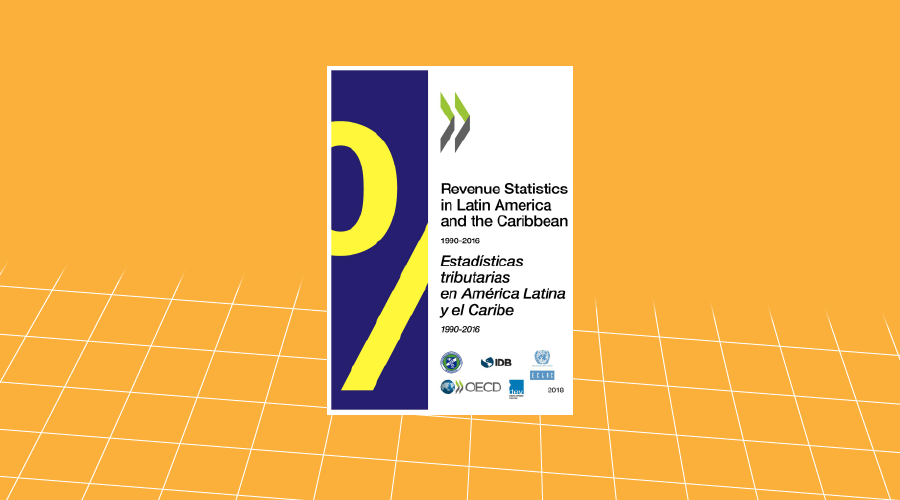Tax revenues in Latin America and the Caribbean (LAC) dipped in 2016, falling further behind average OECD country levels, but a recovery is likely in subsequent years, according to Revenue Statistics in Latin America and the Caribbean 2018. The average tax-to-GDP ratio stood at 22.7% in 2016, a fall of 0.3 percentage points since 2015, the report says.
The 2016 decrease reflects the overall economic environment in the LAC region, where GDP growth slowed between 2012 and 2016. Declining commodity prices partly drove this downturn and remain a key determinant of revenue trends in LAC countries. The decline in tax revenue as a percentage of GDP is expected to reverse in subsequent years thanks to a recovery in commodity prices and an improving economic climate, with GDP growth in LAC forecast to be between 2% and 2.5% in 2018.
Launched during the 30th Regional Seminar on Fiscal Policy in Santiago, the report covers 25 LAC countries and includes Guyana for the first time. It is produced jointly by the Inter-American Centre of Tax Administrations (CIAT), the Economic Commission for Latin America and the Caribbean (ECLAC), the Inter-American Development Bank (IDB), the Organisation for Economic Co-operation and Development (OECD) Centre for Tax Policy and Administration and the OECD Development Centre.
Key findings:
- Between 2015 and 2016, the average tax-to-GDP ratio in the LAC region decreased by 0.3 percentage points to 22.7%. In the OECD area, the ratio increased by 0.3 percentage points to 34.3%.
- In 2016, the tax-to-GDP ratios of the 25 countries covered by the report ranged from 12.6% in Guatemala to 41.7% in Cuba. Barbados and Brazil had the highest tax-to-GDP ratios after Cuba, at 32.2%, while Dominican Republic (13.7%) and Venezuela (14.4%) had the lowest tax-to-GDP ratios after Guatemala.
- In 2016, tax revenues as a percentage of GDP declined in about half the countries in the report, whereas declines were only recorded in four countries in 2015.
- The fall in the LAC average tax-to-GDP ratio in 2016 was driven by a decrease in revenue from income taxes of 0.2 percentage points, which was due to lower corporate income tax (CIT) revenue.
- In 2016, value added tax (VAT) was the biggest source of tax revenue in the LAC region (29.3% of total tax revenues), followed by revenues from taxes on income and profits (27.3%) and from other taxes on goods and services (21.2%). This represented a shift towards value-added taxes and away from taxes on income and profits.
Special features
This year’s report contains two special features. The first identifies trends in fiscal revenues from non-renewable natural resources for 12 commodity-exporting countries in the LAC region in 2016 and 2017. Its main findings are:
- Fiscal revenues from non-renewable natural resources continued to fall on average in the 12 commodity exporters in LAC, from 3.5% of GDP in 2015 to 2.3% in 2016.
- Hydrocarbon-related revenues drove this decrease – falling on average from 5.0% of GDP in 2015 to 3.4% in 2016 in the 10 oil-exporting countries in the region – as a result of a gradual decline in crude oil prices, weak profits at major oil producers and a sharp contraction in regional production.
- Mining revenues, in contrast, held relatively stable at around 0.4% of GDP on average in 10 mineral-producing countries. Corporate income tax receipts from the sector continue to fall, reflecting in part substantial losses realised in 2015.
- Overall, the region’s dependence on non-renewable natural resources declined significantly between 2010 and 2016, reflecting commodity-market dynamics and higher mobilisation of revenues from other sources such as VAT and income tax.
The second special feature examines income taxes in selected countries in Latin America from 1940 to 2016. Its main findings are:
- The degree of income redistribution achieved by personal income tax (PIT) for these countries in the LAC region is much lower than in the European Union and the OECD, meaning that the impact of PIT on inequality in the LAC region is weaker.
- This partly reflects the relatively low level of PIT revenue in Latin America resulting from a narrow tax base and low top marginal rates, as well as high rates of tax evasion.
- In recent years, a number of countries in Latin America have undertaken tax reforms focused on equity that are showing early signs of progress in terms of higher collections and enhanced income redistribution.
Press contacts
1,987 total views, 3 views today

